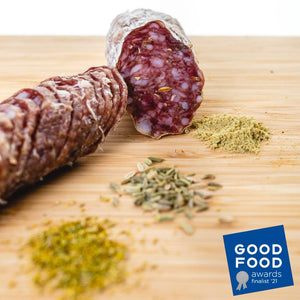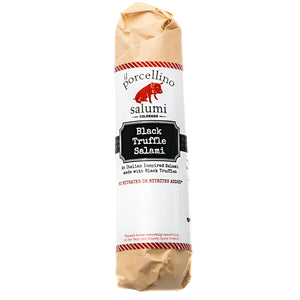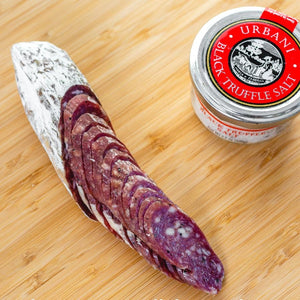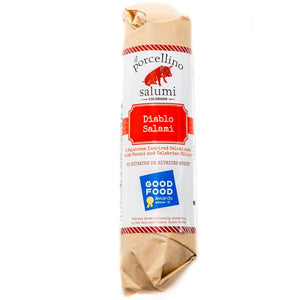Soppressata is dry-cured pork salami. Like most salami, it may have different ingredients and flavors depending on its geographic origin. Italy alone has several distinct regional approaches to making soppressata.
I think people have questions because of it’s uniquely flattened shape. Soppressata doesn’t look like the salami most people are familiar with. It looks different than whole muscle products like coppa and prosciutto too.
I’m passionate about quality cured meat, and soppressata falls into the cured meat category. Here I’ll discuss what soppressata is and what makes it unique.

Soppressata vs. Salami
It’s important to note that soppressata is a type of salami. Compared to most salami, soppressata is different because it’s made with leaner cuts that are coarsely ground. Plus, it’s typically pressed after it is stuffed into the casing and starts to dry. The “pressing” not only lends itself to the oblong finished shape but also its name. In contrast, most salami contains finer ground meat and comes in a cylindrical shape.

The soppressata curing process is the same as other salami. After the meat is ground and seasoned, it’s packed into casings, tied by hand, and hung to dry anywhere from 45 - 60 days.
What’s in Soppressata?
What’s in soppressata is generally determined by where it is made. Typically, soppressata is made with coarsely ground lean pork cuts like the shoulder, loin, and/or ham scraps. Some producers and regions will use fattier meat and less desirable cuts.

Salt, peppercorns, chile peppers, cinnamon, and rosemary are typical soppressata seasonings. However, different regions will use local herbs and spices to impart a more sweet or spicy flavor.
The best-known soppressata salumi come from Italy’s southern regions like Basilicata, Puglia, Calabria, Abruzzo, and Campania. This area takes it’s soppressata quite seriously, and “Sopressata di Calabria” is stamped with the Protected Designation of Origin (Denominazione di Origine Protetta “DOP”) status. The status provides the meat made from this area with name protection when following specific production regulations.
Northern Italy has it’s own versions as well. Soppressata made in Tuscany and Veneto is known as Sopressa. The DOP Sopressa made in Vincenza uses lean cuts and is much spicier than the Calabrian variety. Whereas, Sopressa made in Tuscany uses fattier and leftover parts of the pig.

il porcellino salumi’s Soppressata
At il porcellino salumi, our Soppressata recipe was developed by Phil House, our Operations Manager at our wholesale facility in Basalt. The seasonings he chose for the recipe include garlic, Calabrian chili paste, pink peppercorns, and a Carboy Winery Chardonnay to balance it out. We have tried to press it to get the proper shape but have not had much success. In Italy, producers use wood presses with a hand crank system that flattens the salami over some time. We are not lucky enough to have a press system, but the shape doesn’t change the flavor!

Soppressata is a classic and sophisticated salami because of the use of lean pork meat and the best lard. When combined, the lean meat and lard create a luscious texture and a salami that melts in your mouth. If you can get your hands on soppressata, I recommend trying it. Try ones from different regions and producers. You’ll enjoy the variety of sweet and spicy notes. Soppressata is great alone, on a charcuterie board, in a sandwich, and even in sauces and dishes.







